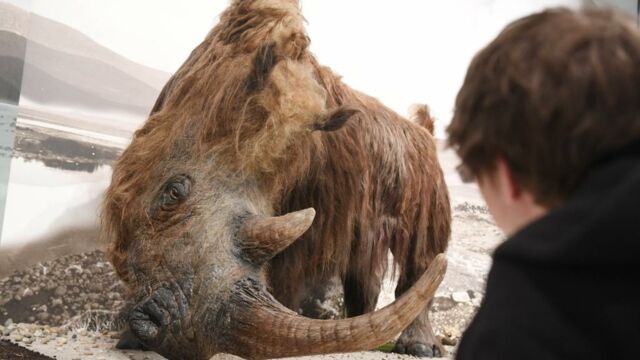Scientists make unexpected discovery inside 14,000-year-old frozen puppy

In 2020, scientists made an amazing discovery. They found some rather dangerous giants in the stomach of a 14,000-year-old prehistoric puppy.
The 14,400-year-old Ice Age puppywas discovered frozen and had hairy tissues and a twig in its stomach which prompted researchers to question just what the prehistoric canine may have eaten.
Discover our latest podcast
Finding a wooly rhino and cave lion inside Ice Age puppy
In 2020 genetic analysts from Stockholm's Natural History Museum confirmed that the hair belonged to two massive beats, a woolly rhino and a cave lion.
More under this adMore under this adBoth the woolly rhino and the cave lion went extinct around this time meaning that the puppy may have eaten one of the last remaining of their species. Dr Sergey Fedorov of Russia’s North-Eastern Federal University stated:
I am very happy that DNA analysis has confirmed this as a woolly rhino.More under this adMore under this ad
Thepuppywas famously discovered in Tumat, in the Sakha Republic of Siberia, in 2011. But, this discovery was not the only exciting one as the flesh found inside its stomach was rectangular in shape, indicating human activity.
Follow this thread for an almost unbelievable story, hiding in the SI of this paper:https://t.co/2wnZTGVwVg
— Centre for Palaeogenetics (@CpgSthlm) August 17, 2020
Ten years ago, a roughly 14,000 year old frozen #dog or #wolf#puppy was found in Russia. It's been named Tumat.
Subsequently, an autopsy of Tumat was conducted (1/n). pic.twitter.com/FtV3SIZmjL
Dr Sergey continued to explain that such a shape could not be achieved naturally by the teeth of another animal, which means it must have been cut away by a human and fed to the puppy. He continued:
I noticed that the shape of the skin was rather strange. It was rectangular. My experience of taxidermy shows that skin could not tear like this in a natural way, if it was bitten off by an animal, for example.More under this adMore under this ad
It seems likely this piece of skin with such even edges was cut artificially by an ancient human. The puppy perhaps found the butchering waste of the carcass. When I saw this piece in its stomach was amazed. I thought it could be the trace of human activity.
Read more:
⋙ Prehistoric skeleton discovered in a cave system in Mexico has forced constructions to stop
⋙ Incredible discovery of over 500 prehistoric standing stones in Spain
Identifying the DNA of the woolly rhino
An expert in evolutionary genetics at the Centre for Palaeogenetics, Love Dalen has explained how they identified the DNA of the woolly rhinoand why the flesh found in the puppy's stomach was so significant. He told CNN:
More under this adMore under this adWe have a reference database and mitochondrial DNA from all mammals, so we checked the sequence data against that and the results that came back—it was an almost perfect match for woolly rhinoceros. It's completely unheard of.
He continued:
I'm not aware of any frozen Ice Age carnivore where they have found pieces of tissue inside. This puppy, we know already, has been dated to roughly 14,000 years ago. We also know that the woolly rhinoceros became extinct 14,000 years ago. So, potentially, this puppy has eaten one of the last remaining woolly rhinos.More under this adMore under this ad
Dalen also believes that the puppy 'must have died very shortly after eating the rhino' as the meat was not very well digested. He also speculates that if it wasn't due to human activity it was possible that the pup's mother hunted down a baby rhino for her pup to eat:
We don't know if it was a wolf, but if it was a wolf cub, maybe it came across a baby rhino that was dead, or the (adult) wolf ate the baby rhino. Maybe as they were eating it, the mother rhino had her revenge.More under this adMore under this ad
While we don't know how the puppy died we do know it could have eaten one of the worlds last woolly rhinos.
Read more:Researchers discover prehistoric fossils of a rare bear-dog hybrid
Sources used:
CNN: A 14,000-year-old puppy, whose perfectly preserved body was found in Russia, munched on a woolly rhino for its last meal